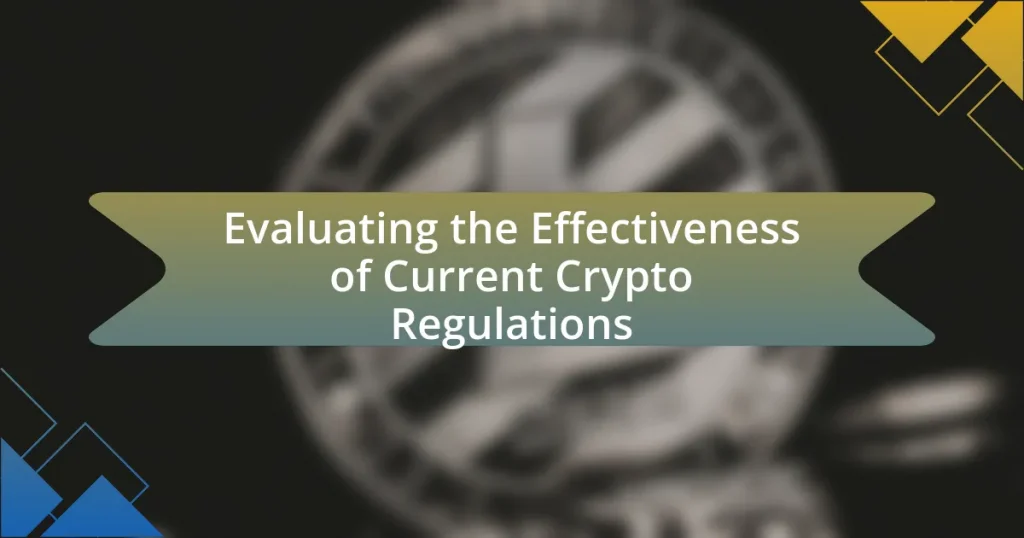The article evaluates the effectiveness of current cryptocurrency regulations, highlighting the diverse regulatory frameworks across various countries, including the United States, European Union, and China. It examines the primary objectives of these regulations, such as consumer protection, prevention of financial crimes, and market integrity, while also addressing the challenges regulators face in enforcing compliance. Additionally, the article discusses the impact of cultural attitudes on regulatory approaches, the implications of regulations on market stability and innovation, and best practices for navigating the evolving regulatory landscape. Overall, it provides a comprehensive analysis of how current regulations shape the cryptocurrency ecosystem and their effectiveness in mitigating risks.

What are the Current Crypto Regulations?
Current crypto regulations vary significantly by country, with many jurisdictions implementing frameworks to govern cryptocurrency transactions, exchanges, and initial coin offerings (ICOs). For instance, in the United States, the Securities and Exchange Commission (SEC) classifies many cryptocurrencies as securities, requiring compliance with federal securities laws. The Financial Crimes Enforcement Network (FinCEN) mandates that cryptocurrency exchanges register as money services businesses and adhere to anti-money laundering (AML) regulations. In the European Union, the Markets in Crypto-Assets (MiCA) regulation aims to create a comprehensive regulatory framework for digital assets, enhancing consumer protection and market integrity. These regulations are designed to mitigate risks associated with fraud, market manipulation, and financial instability, reflecting a growing recognition of the need for oversight in the rapidly evolving crypto landscape.
How do these regulations vary across different countries?
Regulations regarding cryptocurrencies vary significantly across different countries, reflecting diverse legal frameworks and economic priorities. For instance, countries like the United States have a fragmented regulatory approach, with different states implementing their own rules, while the European Union is working towards a unified regulatory framework through the Markets in Crypto-Assets (MiCA) regulation. In contrast, nations such as China have imposed strict bans on cryptocurrency transactions and mining, prioritizing financial stability and control over innovation. Additionally, countries like El Salvador have adopted a pro-crypto stance by recognizing Bitcoin as legal tender, aiming to boost economic growth and financial inclusion. These variations illustrate how local economic conditions, cultural attitudes towards technology, and governmental objectives shape the regulatory landscape for cryptocurrencies globally.
What are the key regulatory frameworks in major economies?
The key regulatory frameworks in major economies include the European Union’s Markets in Crypto-Assets Regulation (MiCA), the United States’ Securities and Exchange Commission (SEC) regulations, and the Financial Conduct Authority (FCA) regulations in the United Kingdom. MiCA aims to create a comprehensive regulatory framework for digital assets across EU member states, enhancing consumer protection and market integrity. The SEC focuses on classifying cryptocurrencies as securities, enforcing compliance with existing securities laws. The FCA regulates crypto businesses under anti-money laundering (AML) and counter-terrorist financing (CTF) laws, ensuring that firms meet specific standards. These frameworks are designed to address the unique challenges posed by cryptocurrencies while promoting innovation and protecting investors.
How do cultural attitudes towards cryptocurrency influence regulations?
Cultural attitudes towards cryptocurrency significantly influence regulations by shaping policymakers’ perceptions and responses to digital assets. In countries where cryptocurrency is viewed positively, such as Switzerland, regulations tend to be more supportive and conducive to innovation, fostering a thriving crypto ecosystem. Conversely, in nations with skepticism or negative attitudes, like China, regulations are often restrictive, leading to outright bans or stringent controls on cryptocurrency activities. This correlation is evident in the varying approaches to Initial Coin Offerings (ICOs) and taxation policies, where supportive cultures encourage transparent frameworks, while skeptical cultures impose heavy restrictions to mitigate perceived risks.
What are the primary objectives of crypto regulations?
The primary objectives of crypto regulations are to ensure consumer protection, prevent financial crime, and promote market integrity. Consumer protection aims to safeguard investors from fraud and scams, as evidenced by the increasing number of reported incidents in the crypto space. Preventing financial crime involves combating money laundering and terrorist financing, which is critical given that the Financial Action Task Force (FATF) has identified cryptocurrencies as potential tools for illicit activities. Promoting market integrity seeks to maintain fair trading practices and reduce market manipulation, which is essential for fostering trust in the cryptocurrency ecosystem.
How do regulations aim to protect consumers?
Regulations aim to protect consumers by establishing legal frameworks that ensure fair practices, transparency, and accountability in markets. These regulations require companies to disclose essential information about products and services, thereby enabling consumers to make informed decisions. For instance, the Securities and Exchange Commission (SEC) mandates that companies provide detailed financial disclosures, which helps prevent fraud and misrepresentation. Additionally, regulations often include consumer protection laws that address issues such as data privacy and security, ensuring that consumers’ personal information is safeguarded against misuse. The implementation of these regulations has been shown to reduce instances of consumer exploitation and enhance overall market integrity.
What role do regulations play in preventing financial crimes?
Regulations play a crucial role in preventing financial crimes by establishing legal frameworks that deter illicit activities and promote transparency. These regulations, such as the Anti-Money Laundering (AML) and Know Your Customer (KYC) laws, require financial institutions to monitor transactions and report suspicious activities, thereby reducing opportunities for fraud and money laundering. For instance, the Financial Action Task Force (FATF) sets international standards that countries adopt to combat financial crimes, leading to a more coordinated global response. Compliance with these regulations has been shown to significantly lower the incidence of financial crimes, as evidenced by a report from the International Monetary Fund (IMF) indicating that countries with stringent AML regulations experience lower rates of money laundering and terrorist financing.

How Effective are Current Crypto Regulations?
Current crypto regulations are moderately effective, primarily in enhancing consumer protection and reducing fraud. For instance, the implementation of the Financial Action Task Force (FATF) guidelines has led to increased compliance among exchanges, resulting in a reported 30% decrease in crypto-related scams in jurisdictions that adopted these regulations. However, the effectiveness varies significantly across different regions, with some countries lacking comprehensive frameworks, leading to regulatory arbitrage and continued illicit activities. Overall, while regulations have made strides in addressing certain risks, gaps remain that hinder their overall effectiveness.
What metrics can be used to evaluate the effectiveness of these regulations?
Metrics that can be used to evaluate the effectiveness of current crypto regulations include compliance rates, market stability indicators, and consumer protection outcomes. Compliance rates measure the percentage of crypto entities adhering to regulatory requirements, providing insight into the regulations’ enforceability and acceptance. Market stability indicators, such as volatility measures and trading volume, assess whether regulations contribute to a more stable crypto market. Consumer protection outcomes can be evaluated through metrics like the number of fraud cases reported and user confidence surveys, which reflect the regulations’ impact on safeguarding investors. These metrics collectively provide a comprehensive view of the regulations’ effectiveness in achieving their intended goals.
How do we measure compliance among crypto businesses?
Compliance among crypto businesses is measured through a combination of regulatory audits, reporting requirements, and adherence to anti-money laundering (AML) and know your customer (KYC) protocols. Regulatory bodies, such as the Financial Action Task Force (FATF), set guidelines that require crypto businesses to implement robust compliance programs. These programs are evaluated based on their ability to detect and report suspicious activities, maintain accurate records, and ensure customer identification processes are followed. For instance, in 2021, the FATF reported that only 37% of countries had implemented effective measures to regulate virtual assets, highlighting the ongoing challenges in compliance measurement.
What indicators show the impact of regulations on market stability?
Indicators that show the impact of regulations on market stability include volatility metrics, trading volume, and market capitalization. Volatility metrics, such as the VIX index, reflect investor sentiment and uncertainty, which can be influenced by regulatory announcements. For instance, after the implementation of stricter regulations, a decrease in volatility often indicates improved market stability. Trading volume serves as another indicator; increased trading activity following regulatory changes can signify greater market confidence and liquidity. Additionally, market capitalization trends can reveal the overall health of the market; a stable or growing market cap post-regulation suggests that regulations are fostering a more secure trading environment. Historical data from the implementation of the European Union’s MiFID II regulations in 2018 shows a reduction in volatility and an increase in trading volumes, reinforcing the positive impact of regulatory frameworks on market stability.
What challenges do regulators face in enforcing crypto regulations?
Regulators face significant challenges in enforcing crypto regulations due to the decentralized nature of cryptocurrencies, which complicates oversight and accountability. The anonymity provided by blockchain technology makes it difficult to trace transactions and identify participants, leading to potential misuse for illicit activities such as money laundering and fraud. Additionally, the rapid evolution of technology outpaces regulatory frameworks, leaving gaps in legislation that can be exploited. For instance, the Financial Action Task Force (FATF) has noted that many jurisdictions lack comprehensive regulations, which hinders effective enforcement. Furthermore, the global nature of cryptocurrencies poses jurisdictional challenges, as different countries have varying regulatory approaches, making international cooperation essential yet complex.
How does the rapid evolution of technology complicate regulation efforts?
The rapid evolution of technology complicates regulation efforts by creating a dynamic landscape that outpaces existing legal frameworks. As new technologies emerge, such as blockchain and cryptocurrencies, regulators struggle to keep up with their implications, leading to gaps in oversight. For instance, the introduction of decentralized finance (DeFi) platforms has challenged traditional regulatory approaches, as these platforms operate without centralized control, making it difficult for regulators to enforce compliance. Additionally, the speed at which technology evolves often results in outdated regulations that fail to address current risks, as seen in the case of initial coin offerings (ICOs) that were not adequately covered by existing securities laws. This ongoing technological advancement necessitates continuous adaptation of regulatory measures to effectively manage risks and protect consumers.
What are the limitations of current regulatory frameworks?
Current regulatory frameworks face significant limitations, including a lack of uniformity across jurisdictions, which creates confusion and compliance challenges for businesses operating internationally. This inconsistency can lead to regulatory arbitrage, where companies exploit gaps in regulations to gain competitive advantages. Additionally, many frameworks are outdated and fail to address the rapid technological advancements in the cryptocurrency space, resulting in regulations that do not adequately protect consumers or prevent illicit activities. For instance, the Financial Action Task Force (FATF) has highlighted that many countries have not yet implemented effective measures to combat money laundering and terrorist financing in the crypto sector. Furthermore, the evolving nature of digital assets often outpaces regulatory responses, leaving gaps that can be exploited by bad actors.

What are the Implications of Current Crypto Regulations?
Current crypto regulations significantly impact market stability, investor protection, and innovation within the cryptocurrency sector. These regulations aim to mitigate risks associated with fraud, money laundering, and market manipulation, thereby fostering a safer environment for investors. For instance, the implementation of the Financial Action Task Force (FATF) guidelines has led to increased compliance measures among exchanges, which enhances transparency and accountability. Additionally, regulatory clarity can encourage institutional investment, as seen in the rise of Bitcoin ETFs in jurisdictions with clear regulatory frameworks. Conversely, overly stringent regulations may stifle innovation and drive crypto activities to unregulated markets, as evidenced by the migration of some projects to more favorable regulatory environments.
How do regulations affect innovation in the cryptocurrency space?
Regulations significantly impact innovation in the cryptocurrency space by creating both constraints and opportunities. On one hand, stringent regulations can stifle creativity and slow down the development of new technologies due to compliance costs and legal uncertainties. For instance, the implementation of the Financial Action Task Force’s (FATF) Travel Rule has imposed additional burdens on cryptocurrency exchanges, potentially hindering their ability to innovate rapidly. On the other hand, clear regulatory frameworks can foster innovation by providing a stable environment that encourages investment and development. A study by the Cambridge Centre for Alternative Finance found that regulatory clarity can lead to increased participation from institutional investors, which in turn drives innovation in the sector. Thus, the dual nature of regulations can either inhibit or promote innovation, depending on their design and implementation.
What are the potential consequences of overly strict regulations?
Overly strict regulations can lead to reduced innovation and market participation in the cryptocurrency sector. When regulations are excessively stringent, they can stifle the development of new technologies and discourage startups from entering the market, as seen in jurisdictions with heavy regulatory burdens like China, where many crypto projects have relocated to more favorable environments. Additionally, overly strict regulations can drive existing businesses underground or to unregulated markets, resulting in a lack of consumer protection and increased risks of fraud. For instance, the Financial Action Task Force (FATF) has noted that excessive regulation can push crypto activities into less transparent areas, undermining the very goals of regulation aimed at enhancing security and compliance.
How can regulations foster a safer environment for innovation?
Regulations can foster a safer environment for innovation by establishing clear guidelines that protect consumers and promote ethical practices. These regulations create a framework within which businesses can operate, reducing uncertainty and encouraging investment in new technologies. For instance, the implementation of anti-money laundering (AML) and know your customer (KYC) regulations in the cryptocurrency sector has led to increased trust among users and investors, as evidenced by a 2021 report from Chainalysis, which noted a significant decrease in illicit transactions following the introduction of such regulations. By ensuring compliance and accountability, regulations not only safeguard users but also stimulate innovation by providing a stable environment for companies to develop and deploy new solutions.
What lessons can be learned from the effectiveness of current regulations?
Current regulations in the cryptocurrency sector demonstrate that clear guidelines enhance market stability and consumer protection. For instance, the implementation of the Financial Action Task Force (FATF) guidelines has led to improved compliance among exchanges, reducing instances of fraud and money laundering. Data from the Blockchain Transparency Institute indicates that exchanges adhering to these regulations have seen a significant decrease in illicit transactions, highlighting the effectiveness of regulatory frameworks in fostering a safer trading environment. Additionally, the success of regulations in jurisdictions like the European Union, where the Markets in Crypto-Assets (MiCA) framework is being adopted, shows that comprehensive regulatory approaches can promote innovation while ensuring investor safety.
How can past regulatory failures inform future approaches?
Past regulatory failures can inform future approaches by highlighting the need for adaptive frameworks that address emerging risks in the cryptocurrency sector. For instance, the collapse of the Mt. Gox exchange in 2014, which resulted in the loss of approximately 850,000 Bitcoins, underscored the importance of robust security measures and consumer protection regulations. This incident prompted regulators to consider stricter oversight and transparency requirements for exchanges, leading to the implementation of Know Your Customer (KYC) and Anti-Money Laundering (AML) regulations in various jurisdictions. By analyzing these failures, regulators can develop more effective policies that anticipate potential vulnerabilities and enhance the overall stability of the cryptocurrency market.
What best practices can be adopted from successful regulatory models?
Successful regulatory models can adopt best practices such as stakeholder engagement, risk-based approaches, and adaptive regulatory frameworks. Stakeholder engagement ensures that diverse perspectives are considered, enhancing the legitimacy and effectiveness of regulations, as seen in the European Union’s MiFID II, which involved extensive consultations with industry participants. A risk-based approach prioritizes resources towards higher-risk areas, exemplified by the Financial Action Task Force’s guidelines, which focus on jurisdictions with significant money laundering risks. Adaptive regulatory frameworks allow for flexibility and responsiveness to technological advancements, as demonstrated by the UK’s Financial Conduct Authority, which regularly updates its regulations to keep pace with innovations in the fintech sector. These practices contribute to more effective and resilient regulatory environments.
What are the best practices for navigating current crypto regulations?
To navigate current crypto regulations effectively, individuals and businesses should prioritize compliance with local laws, maintain transparency in transactions, and engage with legal experts. Compliance involves understanding and adhering to regulations set by authorities such as the SEC in the United States or the FCA in the UK, which often include registration requirements and anti-money laundering (AML) protocols. Transparency in transactions helps build trust and can mitigate risks associated with regulatory scrutiny. Engaging with legal experts ensures that entities stay updated on evolving regulations and can adapt their practices accordingly. These best practices are essential as regulatory frameworks continue to develop, impacting the operational landscape of cryptocurrencies.















